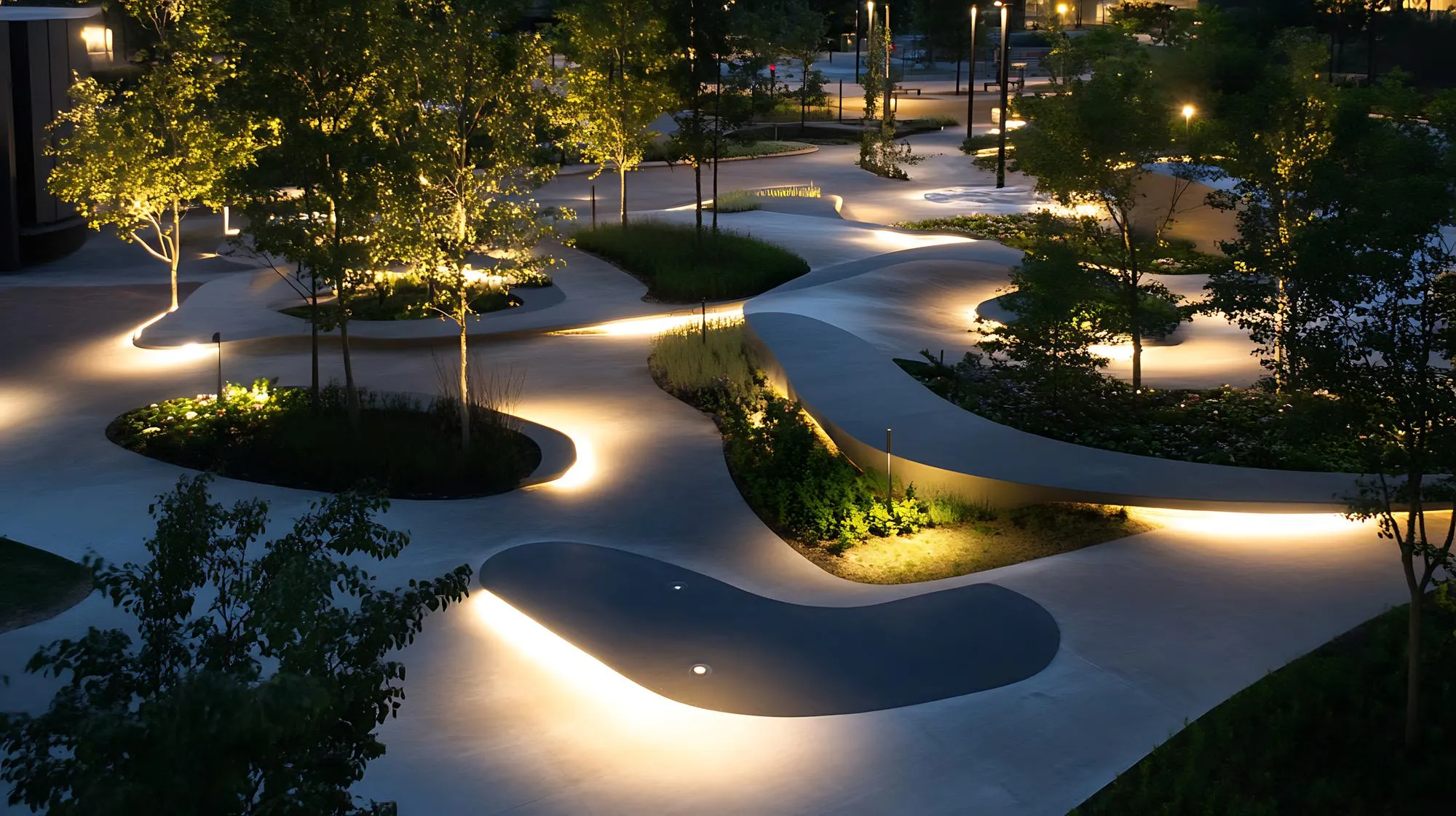Integrating outdoor lighting into your landscape design can transform your garden, patio, or yard into a stunning evening retreat. Whether you’re looking to enhance security, highlight architectural features, or create an inviting atmosphere for entertaining, well-designed outdoor lighting can elevate your landscape and extend the usability of your outdoor spaces into the evening hours. In this post, we’ll explore how to integrate outdoor lighting into your landscape design to enhance beauty, functionality, and ambiance.
Why Outdoor Lighting Matters
Outdoor lighting is more than just a functional addition to your landscape. It enhances the beauty of your home and garden while providing practical benefits, such as:
- Increased Curb Appeal: Lighting can highlight architectural features, trees, pathways, and garden beds, making your property more appealing both during the day and at night.
- Improved Safety and Security: Properly placed lighting around walkways, entrances, and driveways helps improve visibility and reduces the risk of accidents or intrusions.
- Extended Use of Outdoor Spaces: Lighting allows you to enjoy your outdoor areas at night, making your garden, patio, or deck usable long after the sun sets.
- Ambient Mood Setting: Lighting creates a relaxing atmosphere, perfect for evening relaxation, dining, or social gatherings.
Key Types of Outdoor Lighting
To integrate outdoor lighting into your landscape design effectively, it’s important to understand the different types of lighting available. Here are the most common types used in landscape design:
- Pathway Lighting
- Pathway lights illuminate walkways, garden paths, and driveways, guiding visitors and ensuring safety. They are typically low to the ground and come in various styles, including stake lights, bollards, and lanterns.
- Outdoor lighting installation services can help you select and install the right lights to suit your walkways.
- Spotlights and Floodlights
- Spotlights are focused beams of light used to highlight specific features, such as trees, sculptures, or architectural details. Floodlights, on the other hand, provide a broader spread of light, ideal for illuminating larger areas like patios, decks, or the exterior of your home.
- Both types of lighting can be placed strategically to create drama and focal points in your landscape.
- Up-Lighting
- Up-lighting involves placing lights at the base of trees, shrubs, or architectural features and directing the light upwards. This creates dramatic shadows and highlights the shape of the object.
- Up-lighting is perfect for emphasizing tree canopies, statues, or pergolas, giving your yard a more dynamic and sculptural look at night.
- Down-Lighting
- Down-lighting is a technique where lights are installed overhead, such as in trees, pergolas, or eaves of your home, to shine downward. This creates a soft, moonlight-like effect and can be used to light pathways or patios.
- This type of lighting creates a natural ambiance and can be ideal for creating a peaceful atmosphere in your garden or outdoor living space.
- String Lights
- String lights are versatile and can be draped over trees, fences, pergolas, or patios to create a soft, festive glow. They are perfect for creating an intimate atmosphere for outdoor dining, entertaining, or relaxing.
- For added appeal, incorporate outdoor lighting installation to customize the design and ensure your lighting is professionally installed.
- Accent Lighting
- Accent lighting adds emphasis to particular garden features, such as flower beds, water features, or ornamental trees. It can also be used to light up small outdoor structures like benches, sculptures, or fountains, enhancing their visual appeal at night.
- Landscape Lighting for Safety
- Consider adding landscape drainage solutions to your design to prevent areas from becoming slippery and hazardous. Combine your drainage system with lighting around potential hazards like steps or uneven ground to ensure safety.
Planning and Positioning Your Outdoor Lighting
Effective outdoor lighting should enhance the beauty of your garden and provide functionality, but it’s important to plan the placement carefully. Here are some tips to ensure your lighting design is well-integrated into your landscape:
- Layer Your Lighting
- For a balanced and cohesive look, layer different types of lighting. For example, you can combine pathway lighting for safety, spotlights to highlight focal points, and up-lighting to create dramatic effects. This layering creates a sense of depth and adds visual interest.
- Consider Scale and Proportions
- When positioning lights, consider the size of the area you’re lighting. For example, use smaller lights for walkways or flower beds and larger lights for lighting trees or large structures.
- Proportions also matter in terms of the placement of lights. If you’re illuminating a large tree, use a more powerful spotlight placed at a distance to create a dramatic effect. For small plants, use softer, low-voltage lighting.
- Use Energy-Efficient Lighting
- To keep your energy consumption low, choose LED lighting, which consumes less electricity and lasts longer than traditional bulbs. Solar-powered lights are also an excellent choice for eco-conscious homeowners, as they don’t require wiring or electricity and work by harnessing sunlight during the day.
- Highlight Key Features
- Identify areas or features in your yard that you want to emphasize, such as a beautiful tree, fountain, or decorative feature. By using spotlights or down-lighting, you can bring attention to these focal points while adding drama and ambiance to your landscape.
- Consider the Environment
- Be mindful of light pollution, especially if you live near natural habitats or areas where wildlife is present. Use downward-facing lights, motion sensors, and dimmers to minimize unnecessary light spillage into the sky or surrounding areas.
- Test and Adjust
- Once your lighting system is installed, test it at night to ensure everything is positioned correctly. Adjust the angle of spotlights, dim lights, or move fixtures if needed to achieve the desired effect.
Combining Lighting with Other Landscape Features
To create a harmonious and functional outdoor space, integrate your lighting design with other landscape features:
- Water Features: Add lighting around ponds, fountains, or waterfalls to highlight the movement and create a peaceful, reflective atmosphere.
- Hardscaping: Illuminate patios, decks, and retaining walls to make them more usable at night while enhancing the design.
- Gardens and Plantings: Use lighting to highlight key plantings and add a warm glow to your flower beds or vegetable gardens.
Integrating outdoor lighting into your landscape design enhances both the beauty and functionality of your outdoor spaces. Properly planned lighting can highlight architectural features, illuminate pathways, and create a welcoming atmosphere for evening gatherings. For residents seeking professional assistance with their landscaping needs, Landscaping in Richmond Hill offers expert services tailored to enhance the beauty and functionality of outdoor spaces.
Conclusion
Integrating outdoor lighting into your landscape design can significantly enhance the beauty, safety, and functionality of your outdoor space. By thoughtfully planning your lighting layout, using the right types of lights, and combining them with your garden’s existing features, you can create a space that shines day and night. Whether you want to create a welcoming entryway, a romantic garden, or a well-lit patio for entertaining, outdoor lighting is the key to unlocking your yard’s full potential.
For a seamless installation, landscaping professionals can help you design and install the perfect lighting plan for your landscape, ensuring your outdoor spaces are both functional and beautiful.





